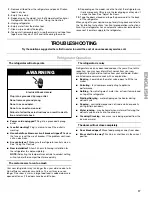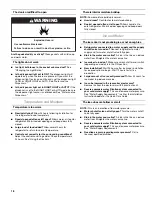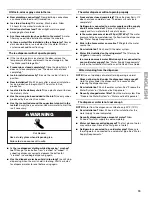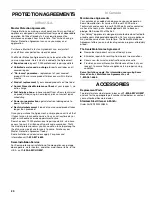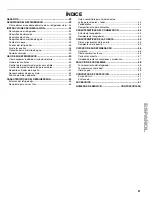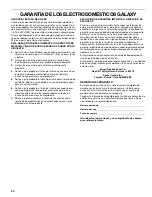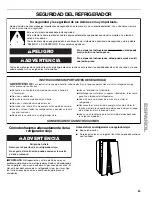
8
Adjust the Doors
Door Closing
1. Place a level inside the refrigerator at the back of the top
shelf. See Graphic 8 in “Refrigerator Doors.”
2. Locate the leveling screws behind the base grille of the
refrigerator on either side.
3. Use a hex-head socket wrench to adjust the rear roller
leveling screws until the refrigerator is level. Turn the rear
roller leveling screw to the right to raise that side of the
refrigerator or turn the leveling screw to the left to lower that
side. See Graphic 10 in “Refrigerator Doors.” Make sure
refrigerator is level before proceeding.
4. Check the door alignment after leveling the refrigerator.
Align the Doors
IMPORTANT: First level the back of the refrigerator as described
in “Door Closing.”
The doors may be uneven after leveling the refrigerator. See
Graphic 9 in “Refrigerator Doors.” The doors are preset at the
factory so that the refrigerator door is higher than the freezer door
by approximately the thickness of a quarter. Once the doors are
loaded with food, they should be even. If the door height needs
to be adjusted AFTER the doors have been loaded with food,
follow the these steps.
1. Use a hex-head socket wrench to adjust the front roller
leveling screws until the doors are even. Turn the front roller
leveling screw to the right to raise that side of the refrigerator
or turn the leveling screw to the left to lower that side. See
Graphic 10 in “Refrigerator Doors.”
NOTE: Open and close both the refrigerator and freezer
doors after each adjustment to check the door alignment.
2. Open the doors and replace the base grille. Line up the grille
support tabs with the metal clips. Push the grille firmly to
snap it into place.
NOTE: Be sure to refasten the Tech Sheet behind the base
grille.
Connect the Water Supply
Read all directions before you begin.
IMPORTANT: If you turn the refrigerator on before the water line
is connected, turn the ice maker OFF.
Connect to Water Line
1. Unplug refrigerator or disconnect power.
2. Turn OFF main water supply. Turn ON nearest faucet long
enough to clear line of water.
3. Locate a ½" to 1
¹⁄₄
" (1.25 cm to 3.18 cm) vertical cold water
pipe near the refrigerator.
IMPORTANT:
■
Make sure it is a cold water pipe.
■
Horizontal pipe will work, but drill on the top side of the
pipe, not the bottom. This will help keep water away from
the drill and normal sediment from collecting in the valve.
4. Determine the length of copper tubing you need. Measure
from the connection on the lower left rear of refrigerator to the
water pipe. Add 7 ft (2.1 m) to allow for cleaning. Use
¹⁄₄
"
(6.35 mm) O.D. (outside diameter) copper tubing. Be sure
both ends of copper tubing are cut square.
5. Using a grounded drill, drill a
¹⁄₄
" hole in the cold water pipe
you have selected.
6. Fasten the shutoff valve to the cold water pipe with the pipe
clamp. Be sure the outlet end is solidly in the
¹⁄₄
" (6.35 mm)
drilled hole in the water pipe and that the washer is under the
pipe clamp. Tighten the packing nut. Tighten the pipe clamp
screws slowly and evenly so the washer makes a watertight
seal. Do not overtighten or you may crush the copper tubing.
7. Slip the compression sleeve and compression nut onto the
copper tubing as shown. Insert the end of the tubing into the
outlet end squarely as far as it will go. Screw compression nut
onto outlet end with adjustable wrench. Do not overtighten.
8. Place the free end of the tubing in a container or sink, and
turn ON the main water supply. Flush the tubing until water is
clear. Turn OFF the shutoff valve on the water pipe. Coil the
copper tubing.
Connect to Refrigerator
Style 1 - Connection to Water Valve
1. Unplug refrigerator or disconnect power.
2. Attach the copper tube to the valve inlet using a compression
nut and sleeve as shown. Tighten the compression nut. Do
not overtighten.
3. Use the tube clamp on the back of the refrigerator to secure
the tubing to the refrigerator as shown. This will help avoid
damage to the tubing when the refrigerator is pushed back
against the wall.
4. Turn shutoff valve ON.
5. Check for leaks. Tighten any connections (including
connections at the valve) or nuts that leak.
6. The ice maker is equipped with a built-in water strainer. If
your water conditions require a second water strainer, install
it in the
¹⁄₄
" (6.35 mm) water line at either tube connection.
Obtain a water strainer from your nearest appliance dealer.
A. Cold water pipe
B. Pipe clamp
C. Copper tubing
D. Compression nut
E. Compression sleeve
F. Shutoff valve
G. Packing nut
A. Tube clamp
B. Copper tubing
C. Compression nut
D. Valve inlet
A
B
C
D
E
F
G
A
B
C
D

















